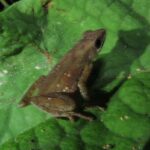- Introduction: A Hidden Gem in Brazil's Limestone Labyrinths
- Taxonomy and Classification: Where Does Ischnocnema karst Fit?
- Natural Habitat: Life Among Brazil’s Limestone Secrets
- Physical Characteristics: Master of Camouflage and Subtle Beauty
- Behavior and Life Cycle: Unique Adaptation Through Direct Development
- Ecological Role: Tiny Amphibian, Far-Reaching Impact
- Threats and Conservation Status: Vulnerable in a Rapidly Changing Environment
- Cultural and Scientific Significance: Symbolizing Nature’s Secrets
- Conclusion: Preserving the Small Wonders of Our World
Introduction: A Hidden Gem in Brazil’s Limestone Labyrinths#
Hidden amidst the lush forests and limestone caves of eastern Brazil, a rain-soaked evening reveals a chorus of peculiar, melodic calls echoing softly through the dense foliage. Among the callers is a tiny, elusive creature that few have encountered—the Ischnocnema karst. First scientifically described only in recent years, this diminutive frog captivates biologists and nature enthusiasts alike with its remarkable adaptability and intriguing behaviors.
The Ischnocnema karst, classified scientifically as Ischnocnema karst, belongs to the vast group of frogs inhabiting the Brazilian Atlantic forest. This species symbolizes both the wonder and fragility of this unique ecosystem. Discovering its elusive nature and ecological role can connect us intimately to a landscape often overshadowed by Brazil’s more famous Amazon basin. Intriguing and captivating, the species also serves as a poignant reminder of conservation’s essential role in safeguarding otherwise overlooked organisms.
Taxonomy and Classification: Where Does Ischnocnema karst Fit?#
A member of the large, diverse family Brachycephalidae, Ischnocnema karst belongs to the genus Ischnocnema, a group well-known for their intriguing diversity and specialization. Frogs within this genus lack aquatic larvae stages—they undergo direct development from egg to juvenile froglet, bypassing the traditional tadpole stage entirely. This adaptation frees them from dependence on standing water, allowing them to occupy unique ecological niches not available to many other amphibians.
First described in detail by scientists Carvalho, Martins, and Giaretta in 2010, the name “karst” honors the distinctive limestone (karstic) landscapes that characterize its habitat. Closely related species within the genus, including Ischnocnema henselii, exhibit similar adaptations but boast differing appearances and ecological preferences. Thus, exploring the taxonomy and relationships within this genus offers fascinating insights into evolutionary adaptability.
Natural Habitat: Life Among Brazil’s Limestone Secrets#
Restricted primarily to Brazil’s Atlantic Forest region, notably within Minas Gerais and nearby regions characterized by karst topography, Ischnocnema karst has evolved as a habitat specialist. It thrives within intricate limestone caves, rocky outcrops, and shaded forest formations where humidity remains high year-round. Here, water trickles melodiously through hidden caverns, fostering vibrant communities filled with mosses, lichens, ferns, and fungi—a paradise perfectly aligned with the amphibian lifestyle.
The frog frequently occupies cave entrances’ edges and rocky depressions, exploiting moisture-rich microhabitats far from brooks and rivers. These protected, humid niches guard against dehydration and give shelter from challenging environmental variations. Thick vegetation cover, optimal humidity, and stable temperatures offer an ideal microclimate for its unique reproductive strategy.
Physical Characteristics: Master of Camouflage and Subtle Beauty#
Ischnocnema karst is a captivating specimen, meticulously adapted for survival in its dark, moistened habitat. Adults rarely exceed 30 mm (about 1 to 1.2 inches), making them notably tiny compared to more familiar amphibians. Despite their diminutive size, close inspection reveals an extraordinary degree of beauty and adaptation.
Typically colored in cryptic shades of browns, grays, and greens—with strikingly mottled patterns across its skin—the species is incredibly difficult to spot against the wet rock, bark, and decomposing leaf litter it favors. Its beautifully textured skin provides further camouflage, blending seamlessly into the moss-covered surfaces of limestone caves. This cryptic coloration, far from being merely aesthetic, is vital in protecting frogs from predators, such as predatory birds and reptiles patrolling these dense forests.
Large eyes positioned on a broadly rounded head provide acute vision, crucial to a lifestyle dependent upon effective hunting and predator avoidance in dimly lit caves and forests. Distinctively, the species exhibits irregular skin bumps, adding further nuance to its disguise among its rocky surroundings.
Behavior and Life Cycle: Unique Adaptation Through Direct Development#
Unlike many amphibians whose offspring mature through water-bound tadpole stages, Ischnocnema karst displays direct development. It lays eggs in high-humidity, sheltered locations within caves and rocky crevices. Remarkably, these eggs hatch directly into miniature versions of adults—complete with fully developed lungs and legs capable of terrestrial life immediately upon hatching.
This approach eliminates the dependency on water bodies for breeding, allowing the frogs to colonize habitat niches where other amphibians cannot. Eggs are typically deposited in small clusters under moist leaves or within moss-covered cave walls, insulated from desiccation and interference from predators or competitors. Females display selective behaviors when choosing oviposition sites, demonstrating a keen instinct for survival shared across generations.
The males, primarily nocturnal and active during rainy seasons, use soft, distinctive calls resonating throughout their karst habitats to attract mates. These gentle, rhythmic sounds echo hauntingly through cave chambers and leaf litter, creating a symphony heard only among visitors lucky enough to encounter their secretive habitats.
Ecological Role: Tiny Amphibian, Far-Reaching Impact#
Though modestly sized, Ischnocnema karst holds significant ecological importance within its specialized ecosystem. Primarily insectivorous, the species relies heavily on abundant invertebrate populations inhabiting damp forest floors and cave ecosystems, including spiders, beetles, and ants. In controlling insect numbers, this frog species curbs potential pest outbreaks, indirectly contributing to forest resilience and sustainable ecosystem function.
Meanwhile, Ischnocnema karst serves as prey to larger predators, playing a pivotal role in regional food webs. Its sensitivity to environmental conditions also establishes the species as a potential bioindicator: subtle changes in its presence or behavior may signal broader ecological shifts in forest health and biodiversity.
Threats and Conservation Status: Vulnerable in a Rapidly Changing Environment#
The enchanting niche habitats favored by Ischnocnema karst—limestone caves and moist forests—face ever-increasing threats. Human activities, including mining, deforestation, agricultural expansion, and pollution, have perilously impacted its habitat, posing stark conservation challenges. Additionally, climate change’s potential to alter rainfall patterns and humidity levels could dramatically affect its delicate, moisture-dependent life cycle.
Currently, Ischnocnema karst is classified under the IUCN Red List as Data Deficient, indicating limited information but relatively small and fragmented populations restricted by its specialized habitat. This classification highlights the urgent need for further ecological studies and habitat-focused conservation strategies. Investments in research and habitat management are crucial in safeguarding this species’ future, highlighting the importance of proactive engagement with habitat preservation and sustainable land-use planning.
Cultural and Scientific Significance: Symbolizing Nature’s Secrets#
While not widely known culturally, Ischnocnema karst holds immense scientific value. Researchers studying karst regions use its presence to probe ecological mysteries about cave-adapted amphibians’ evolution, behavior, and genetics. Insights gleaned from studying these frogs contribute to broader academic narratives about cave ecosystems’ evolutionary dynamics and climate sensitivity.
Furthermore, by highlighting overlooked, discrete species like Ischnocnema karst, conservationists reinforce essential narratives about biodiversity’s unseen dimensions, promoting public appreciation for lesser-known creatures crucial to planetary health.
Conclusion: Preserving the Small Wonders of Our World#
Though diminutive and cryptic, Ischnocnema karst stands as a dazzling testament to evolutionary ingenuity, demonstrating how life persists beautifully in specialized environments. Understanding and appreciating this frog is integral to our collective quest to protect endangered ecosystems and their unique inhabitants.
Today, ongoing research and dedicated conservation efforts are essential if we hope to shield Ischnocnema karst from extinction-threatening pressures. It falls upon all nature enthusiasts, conservation advocates, researchers, and policymakers alike to champion habitats that shelter species like this extraordinary frog. We invite you to actively support and protect these enigmatic species and champion biodiversity conservation in Brazil and beyond.







